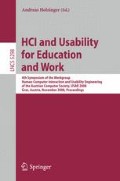Abstract
An end-user questionnaire to measure user experience quickly in a simple and immediate way while covering a preferably comprehensive impression of the product user experience was the goal of the reported construction process. An empirical approach for the item selection was used to ensure practical relevance of items. Usability experts collected terms and statements on user experience and usability, including ‘hard’ as well as ‘soft’ aspects. These statements were consolidated and transformed into a first questionnaire version containing 80 bipolar items. It was used to measure the user experience of software products in several empirical studies. Data were subjected to a factor analysis which resulted in the construction of a 26 item questionnaire including the six factors Attractiveness, Perspicuity, Efficiency, Dependability, Stimulation, and Novelty. Studies conducted for the original German questionnaire and an English version indicate a satisfactory level of reliability and construct validity.
Access this chapter
Tax calculation will be finalised at checkout
Purchases are for personal use only
Preview
Unable to display preview. Download preview PDF.
References
Gediga, G., Hamborg, K.-C., Düntsch, I.: The IsoMetrics Usability Inventory: An operationalisation of ISO 9241-10. Behaviour and Information Technology 18, 151–164 (1999)
Dzida, W., Hofmann, B., Freitag, R., Redtenbacher, W., Baggen, R., Geis, T., Beimel, J., Zurheiden, C., Hampe-Neteler, W., Hartwig, R., Peters, H.: Gebrauchstauglichkeit von Software: ErgoNorm: Ein Verfahren zur Konformitätsprüfung von Software auf der Grundlage von DIN EN ISO 9241 Teile 10 und 11, Schriftenreihe der Bundesanstalt für Arbeitschutz und Arbeitsmedizin [Usability of Software: ErgoNorm: A method to check software conformity on the basis of DIN EN ISO 9241 parts 10 and 11, Institute Report Series of the BAuA]. Bundesanstalt für Arbeitschutz und Arbeitsmedizin, Dortmund, Germany (2000)
Hassenzahl, M.: The effect of perceived hedonic quality on product appealingness. International Journal of Human-Computer Interaction 13, 481–499 (2001)
Kirakowski, J., Corbett, M.: SUMI: The Software Usability Measurement Inventory. British Journal of Educational Technology 24, 210–212 (1993)
Nielsen, J.: Heuristic Evaluation. In: Nielsen, J., Mack, R.L. (eds.) Usability Inspection Methods, pp. 25–62. Wiley, New York (1994)
ISO 9241-10: Ergonomic requirements for office work with visual display terminals (VDTs) - Part 10: Dialogue principles. Beuth, Berlin, Germany (1996)
ISO 9241-11: Ergonomic requirements for office work with visual display terminals (VDTs) - Part 11: Guidance on usability. Beuth, Berlin, Germany (1998)
Preece, J., Rogers, Y., Sharpe, H.: Interaction design: Beyond human-computer interaction. Wiley, New York (2002)
Hassenzahl, M., Burmester, M., Koller, F.: AttrakDiff: Ein Fragebogen zur Messung wahrgenommener hedonischer und pragmatischer Qualität. [AttrakDiff: A questionnaire for the measurement of perceived hedonic and pragmatic quality]. In: Ziegler, J., Szwillus, G. (eds.) Mensch & Computer 2003: Interaktion in Bewegung, Teubner, Stuttgart, Germany, pp. 187–196 (2003)
Lindgaard, G., Dudek, C.: What is this evasive beast we call user satisfaction? Interacting with Computers 15, 429–452 (2003)
Holzinger, A., Searle, G., Kleinberger, T., Seffah, A., Javahery, H.: Investigating Usability Metrics for the Design and Development of Applications for the Elderly. In: Miesenberger, K., Klaus, J., Zagler, W., Karshmer, A. (eds.) ICCHP 2008. LNCS, vol. 5105, pp. 98–105. Springer, Heidelberg (2008)
Norman, D.: Emotional Design: Why We Love (or Hate) Everyday Things. Basic Books, New York (2004)
Tractinsky, N.: Aesthetics and Apparent Usability: Empirical Assessing Cultural and Methodological Issues. In: CHI 1997. Electronic Publications (1997), http://www.acm.org/sigchi/chi97/proceedings/paper/nt.htm
Schrepp, M., Held, T., Laugwitz, B.: The influence of hedonic quality on the attractiveness of user interfaces of business management software. Interacting with Computers 18, 1055–1069 (2006)
Nielsen, J.: Jakob Nielsen’s Alertbox August 5, 2001: First rule of usability: Don’t listen to users (2001), http://www.useit.com/alertbox/20010805.html
Laugwitz, B.: Experimentelle Untersuchung von Regeln der Ästhetik von Farbkombinationen und von Effekten auf den Benutzer bei ihrer Anwendung im Benutzungsoberflächendesign. [Experimental investigation of the aesthetics of colour combinations and of its impact on users when applied to graphical user interface design]. dissertation.de-Verlag im Internet, Berlin (2001)
Komine, K., Sawahata, Y., Uratani, N., Yoshida, Y., Inoue, T.: Evaluation of a prototype remote control for digital broadcasting receivers by using semantic differential method. IEEE Transactions on Consumer Electronics 53(2), 561–568 (2007)
Catell, R.B.: The scree test for the number of factors. Multivariate Behavioural Research 1, 245–276 (1966)
Author information
Authors and Affiliations
Editor information
Editors and Affiliations
Rights and permissions
Copyright information
© 2008 Springer-Verlag Berlin Heidelberg
About this paper
Cite this paper
Laugwitz, B., Held, T., Schrepp, M. (2008). Construction and Evaluation of a User Experience Questionnaire. In: Holzinger, A. (eds) HCI and Usability for Education and Work. USAB 2008. Lecture Notes in Computer Science, vol 5298. Springer, Berlin, Heidelberg. https://doi.org/10.1007/978-3-540-89350-9_6
Download citation
DOI: https://doi.org/10.1007/978-3-540-89350-9_6
Publisher Name: Springer, Berlin, Heidelberg
Print ISBN: 978-3-540-89349-3
Online ISBN: 978-3-540-89350-9
eBook Packages: Computer ScienceComputer Science (R0)

